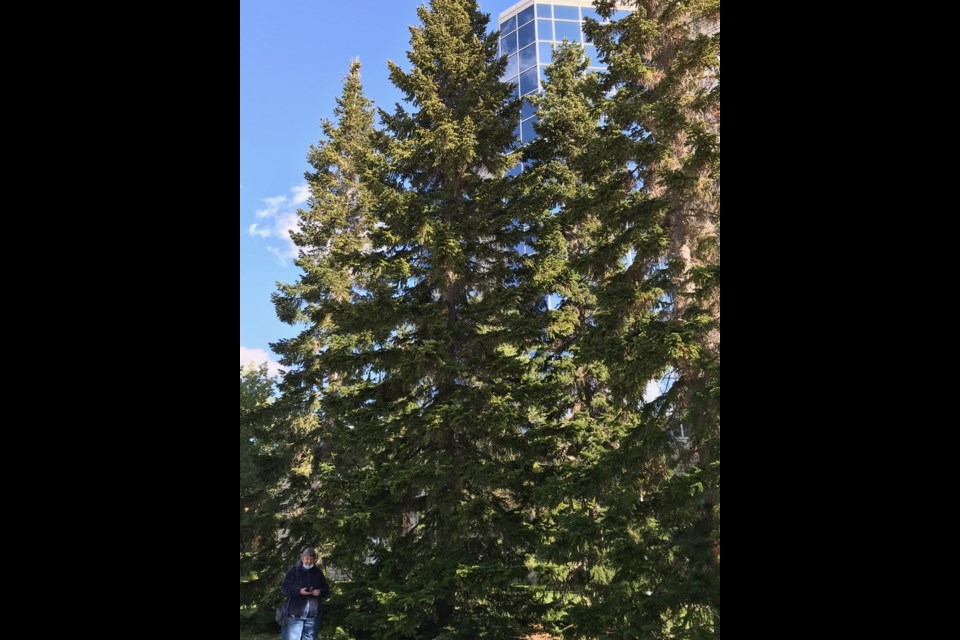Most prairie readers are familiar with pine and spruce which are readily encountered in our urban and rural yards. Larch and fir are less commonly seen and sometimes less readily available but make wonderful additions to our landscapes. Try them! You won’t be disappointed.
Fir (Abies)
Botanical names tell us a lot about our plants. Abies is from the Latin word, abire, to rise, a reference to the tree’s great height. Although tall, firs have a very symmetrical growth habit, especially when young. The common English name, fir, originates with the Old Norse, fyri, or the Old Danish, fyr. Long ago, people used its branches to decorate their homes during the winter solstice, reminding them of the spring to come. Romans used fir trees to decorate their homes for the New Year, while Christians used evergreens as a sign of everlasting life. Fir trees were later used as Christmas trees.
Their needles are soft, huggable (unlike a spruce!), aromatic, and appear flat although they are in fact two-sided.
Plant firs in a sheltered location, protected from drying winds. They do best with even moisture and should be mulched for their first several years to ensure adequate moisture until their root systems are more extensive.
Three species have done well on the prairies.
Balsam fir (Abies balsamea) is native to the boreal forest region across Canada from the east coast to the Rocky Mountains. It is usually found growing in association with aspen, birch and spruce. Long grown as a Christmas trees, its sap is a source of “Canada balsam” used to mount specimens on microscope slides. It is also an ingredient in fragrance.
It is about 10-15 m high and 3-6 m wide (33-50 ft. x 10-20 ft.). The dark green needles, with two white lines on the undersides, are spirally arranged on the twigs. The cones, violet and held upright on the branches, turn brown when ripe. The bark of young balsam fir is smooth and silver grey with prominent resin blisters. With age, it forms rectangular plates.
Balsam firs do best in full sun to partial shade in moist, well drained loam soil, but are adaptable to a variety of growing conditions.
Abies balsamea ‘Nana’ is an attractive dwarf form, a shrub of only 0.6 m by 1.2 m (2 ft. x 4 ft.)., densely branched and globe-shaped. It is well used as an accent plant or in a mixed border.
Siberian fir (Abies sibirica), native to Siberia, China and other parts of Asia, is similar in appearance to balsam fir with a narrow pyramidal form, but slightly shorter. It was first described in 1833 by Carl Friedrich von Ledebour, a German-Estonian botanist who wrote a comprehensive flora of the Russian Empire. The soft green needles are highly aromatic. It is the northern-most growing fir in the world, but sometimes begins growth very early and is damaged by later spring frosts. It is more tolerant of shade and drier conditions than other firs.
Alpine fir, subalpine fir or rocky mountain fir (Abies lasiocarpa) should be much more readily available than it is! It is hardy, drought-tolerant, fast growing, and absolutely gorgeous, providing (almost) instant gratification. The species name, lasiocarpa, is from Greek words, lasios, meaning shaggy and carpos, fruit, referring to the rough cones.
Native to the mountains of Alberta and British Columbia, it has a tall stately form and a relatively narrow spread (10-20 x 4-6 m), making it ideal for a smaller landscape where space is limited. Dense and pyramidal, the smooth, ash-grey bark breaks into grey-brown plates with age. The flat needles are a dark greyish green to bluish green with two white lines on their bottom surface. It is perhaps less tolerant than other fir species of wet soil conditions so plant alpine fir in full sun on well-drained soil.
— Sara Williams is the author and coauthor of many books including Creating the Prairie Xeriscape, Gardening Naturally with Hugh Skinner and, with Bob Bors, the recentlypublished Growing Fruit in Northern Gardens. She continues to give workshops on a wide range of gardening topics throughout the prairies.
This column is provided courtesy of the Saskatchewan Perennial Society (SPS; [email protected] ). Check our website (www.saskperennial.ca) or Facebook page (www.facebook.com/saskperennial) for a list of upcoming gardening events.




